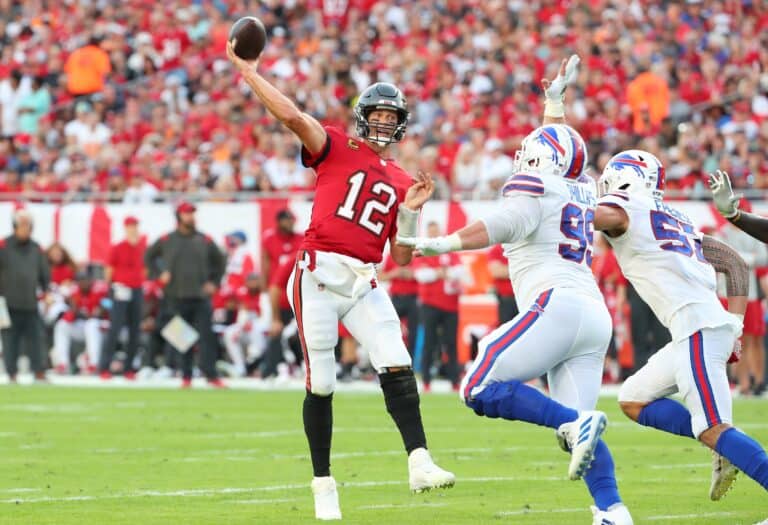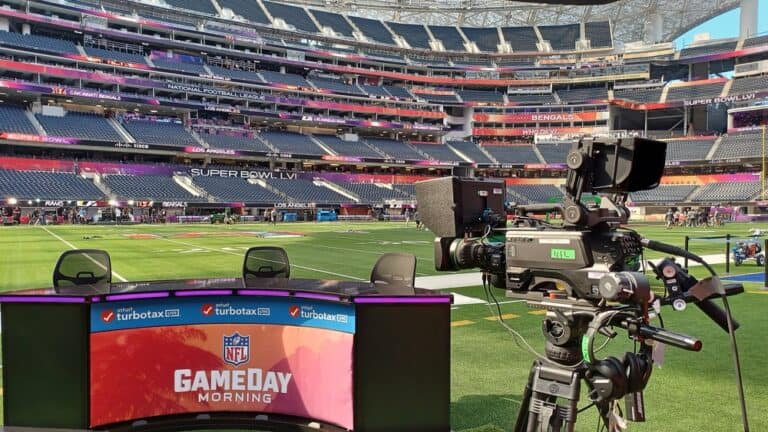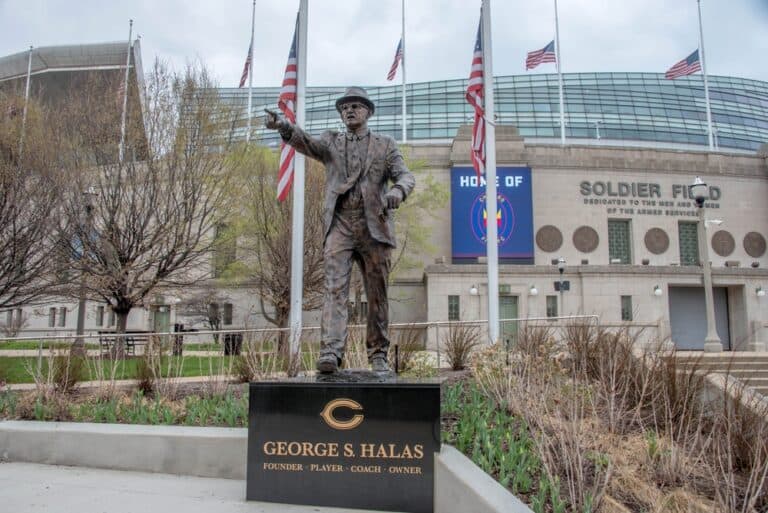Clock Stops When Out Of Bounds In NFL: Explained
Editorial credit: Jamie Lamor Thompson / Shutterstock.com
When it comes to the play clock stopping if the ball goes out of bounds, the rules around this have become more complicated since laws changed in 2008, leading to some confusion amongst fans when watching the game.
The clock stops when the ball goes out of bounds if the ball crosses the line or when the offensive player carrying the ball is moving sideways or forwards as the ball crosses the line, but if the player is deemed to be going backward, then the clock will continue to run.
But there have also been some rule changes around the clock being stopped out of bounds depending on how many minutes are left in the first half and how many are left in the game. So let’s examine the NFL rules around when the clock stops out of bounds.
When Does The Clock Stop Out Of Bounds
Before 2008, the NFL rules around the clock stopping for out-of-bounds were simple, and that was if the player carrying the ball touched the OB line, the clock stopped so the referees could place the ball, and the clock would then only start again once the ball was snapped from the next play.
After the rule change in 2008, the game clock will still stop when the ball is carried out of bounds in most cases, but it will restart once the referee has placed it at the line of scrimmage, ready for the next play and not at the next snap as was the rule prior.
This rule also coincides with the change in the duration of the play clock from 25 seconds to 40 seconds, so once the play clock runs, the offensive team has 40 seconds to start the next play.
But the changes on the clock stopping for out-of-bounds don’t end there.
Does The Clock Always Stop If The Ball Goes Out Of Bounds
Not satisfied with changing a simple and efficient rule, the NFL also decided to alter the conditions under which the game clock stops when the ball goes out of bounds.
Before this rule change, any offensive ball carrier that either ran out of bounds or was tackled out of bounds would stop the clock regardless of what direction the tackled player was moving in at the time.
However, that has now changed. If the referees determine that the player carrying the ball was going backward when they went out-of-bounds, the clock doesn’t stop. Essentially this means that the ball carrier has to either advance or move laterally when they step out-of-bounds for the clock to stop.
If the player has been tackled and their momentum has been stopped and is now moving away from the opponent’s end zone when they go out of bounds, the clock will continue to run, and the offensive team would have the 40 seconds on the play to have the ball set and snap the next play.
What’s important to note here is that if the tackled player’s knee or another part of his body makes contact with the ground infield, and the momentum of the tackle carries him out-of-bounds, this will be ruled down inside the field of play and not an out-of-bounds play.
While some fans may think this is an OB play, it is ruled as a normal tackle, and the clock will continue to run as per the ‘ruled down’ and not out of bounds that would stop the clock.
Why Did The NFL Change The Clock Stops Out Of Bounds Rules
While some may question this new rule, the NFL has been under pressure to improve the game’s speed and prevent unnecessary delaying tactics by the offensive team, especially where they are leading the game with time running out.
Examples of this rule in effect could be where a player may anticipate a tackle and slow down instead of maintaining forward momentum and getting tackled backward out of bounds. Had he continued running ahead until tackled, the clock would have stopped, but because he slowed down or stopped and was carried back and out of bounds, the clock continues to run.
This allows the defense to put pressure on the offensive team and rush them to the next play, plus it forces the offense to have a ‘gaining ground’ mindset at all times during the game.
The Out-Of-Bounds Clock Rules For The End Of The Half And End Of The Game
The out-of-bounds clock rule is still the same at the end of the first half and the end of the game.
For the last two minutes of the first half and the last five minutes of the second half, if the ball goes out-of-bounds, the clock will stop and only restart once the ball is snapped. However, the offense still has to run the next play before the play clock counts down to zero – so that aspect has not changed.
If the play is run outside of those time limits, the normal clock rules apply, so a player tackled out of bounds and deemed going backward by the sideline official at the time they went out-of-bounds would not stop the clock.
Inside the last two minutes of the first half, last five minutes of the second half, and last two minutes of the second half, the clock would stop if the ball went out-of-bounds.
With these new rules, it placed the onus on the offensive coach and team to be more aware of the umpire’s signals on a play when the ball went out-of-bounds, and there have been instances when teams did not see the referee signaling that the clock was still running and ended up forfeiting possession.

Conclusion
The rules that govern when and how the clock stops out of bounds in the NFL will add a new element of strategy for both offense and defense and could well create the result that the NFL is looking to achieve, which is to speed up the game.
Understanding these rules will alleviate confusion on calls made on the field, especially where players go out-of-bounds and the clock doesn’t stop, and you can be the expert in the room and explain why the clock does or does not stop for out-of-bounds in the NFL.
Resources
- https://www.quora.com/What-are-the-NFL-rules-about-stopping-the-clock-when-the-offense-runs-out-of-bounds-I-noticed-twice-during-tonights-NFL-game-the-clock-was-not-stopped-when-this-occurred
- https://blogs.usafootball.com/blog/2108/ask-the-official-does-the-clock-always-stop-when-a-ball-carrier-goes-out-of-bounds-in-the-final-minute-of-a-game
- https://bleacherreport.com/articles/35981-2008-rule-changes-what-every-fan-needs-to-know
- https://en.as.com/en/2021/11/24/nfl/1637712786_467764.html
- https://www.sportsrec.com/nfl-clock-stoppage-rules-6699511.html







